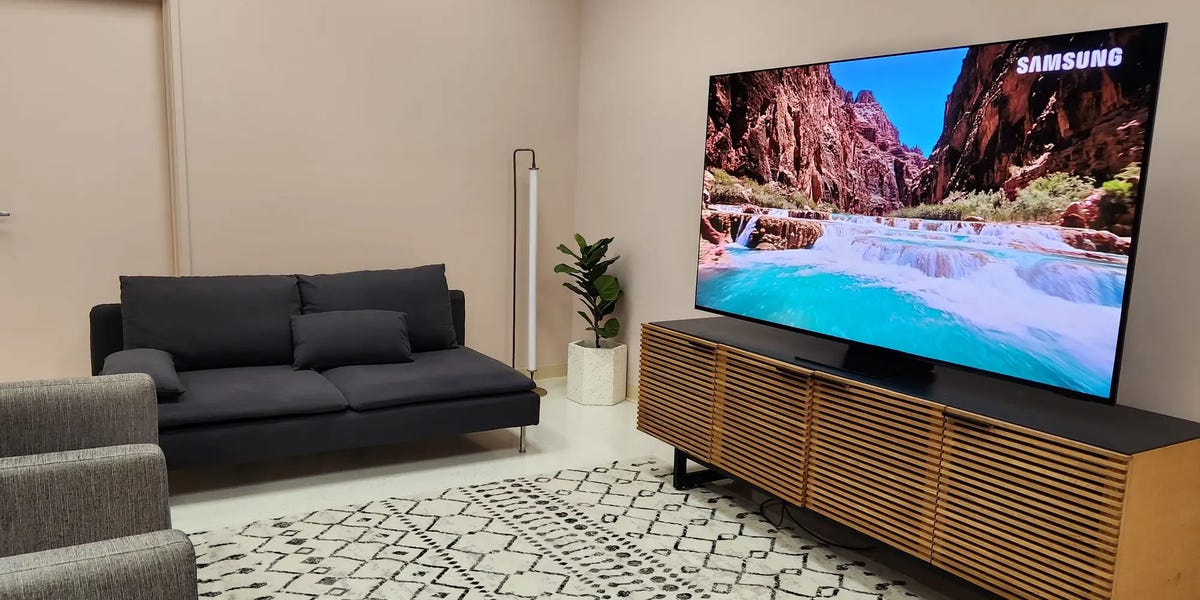
4K TV FAQs
The Samsung S95C uses the Tizen smart TV platform.
Steven Cohen/Insider
When will 2024 4K TV models be released?New 4K TV models are typically released in the spring of every year. Most companies announced their 2024 TV models at the CES tradeshow in January, but official pricing and exact release dates have not been detailed yet. Once 2024 4K TVs hit stores, 2023 models will remain available while supplies last. Though new models will offer some performance upgrades, they’ll likely launch at much higher prices than their 2023 counterparts currently sell for. Generally, we think 2023 4K TV models will remain a better value while they’re still available. What are the best brands for 4K TVs?LG, Samsung, and Sony are among the top TV brands. Though typically more expensive than other options, these companies’ TVs are known for delivering cutting-edge technology, modern designs, and great quality control. If you’re in the market for a premium TV, you can’t go wrong with flagship models from these manufacturers.Meanwhile, brands like TCL, Hisense, and Vizio are top players in the midrange and value-priced TV market. Though build quality isn’t always on par with more expensive brands, these companies offer advanced features, like quantum dots and Mini LED dimming, for less than the competition. If you want the best bang for your buck in a midrange TV, these are the brands you should consider first. Companies like Amazon and Roku have also started to manufacture their own entry-level and midrange TVs with mixed results. Their flagship offerings are decent options when on sale, but you can typically find better displays for less money from TCL, Hisense, or Vizio.Finally, budget brands like Toshiba and Insignia are known for selling entry-level LED displays that use Amazon’s Fire TV operating system. Though inexpensive, these sets are about as basic as TVs get. We typically recommend paying a bit more to get one of our picks for the best 4K TVs listed above, but these displays are decent enough if you just want a cheap TV for casual viewing, especially in a smaller screen size. What size 4K TV should I get?What size 4K TV you should buy really comes down to how much space you have, how far you’re going to sit from your display, and what your budget is. In general, bigger TVs cost more than smaller ones with comparable features, and you’ll need to have enough wall space or a large enough TV stand to accommodate whatever display you get.TV sizes typically start as small as 24 inches and can go up to 98 inches. A few manufacturers have premium models that are even larger. A lot of companies reserve their best picture quality and design features for their bigger sizes. Though not a hard rule, midrange features are often reserved for models that are 50 inches or larger, and high-end features tend to start in 55-inch models. Most companies use 65 inches as their flagship size to highlight their best 4K TVs, and for many people, 65 inches hits just the right sweet spot to offer a solid home theater experience without taking up too much real estate or totally breaking the bank. Check out our best 65-inch TV guide for more display recommendations for that size. And if you want something a little smaller, be sure to visit our guide to the best 55-inch TVs.If space and budget aren’t a concern, what size 4K TV you should get can be best determined by how far you plan to sit from your display. This is because the benefits of 4K resolution become most noticeable when you sit at a distance of about one to 1.5 times the size of your TV. For instance, to get the most out of a 65-inch 4K TV, you should sit between 5.4 and 8.1 feet from your TV. Crutchfield has a handy chart that provides recommended 4K TV sizes based on your seating distance. What are the best smart TV interfaces?Practically any new 4K TV you buy will be a smart TV, which means it features built-in support for accessing popular apps and streaming services. However, different companies use different smart TV interfaces, and some may prefer one platform over another. Here’s a rundown of different smart TV interfaces with details on which TV manufacturers use them:Tizen: SamsungwebOS: LGSmartCast: VizioGoogle TV: Sony, TCL, HisenseRoku TV: Roku, TCL, HisenseFire TV: Amazon, Toshiba, Insignia, Pioneer, HisenseThough a few services may be missing here and there, all of the major streaming players are supported across every platform. However, navigation style, personalization options, and extra features differ across each system.We prefer Roku’s interface for being the simplest, most user-friendly, and most reliable of the bunch, but its visual style is a bit outdated compared to other operating systems that present a more content-focused approach. Ultimately, every system has its own pros and cons, and they all get the job done. But if you are unhappy with your TV’s built-in interface, you can always purchase a separate streaming device with the interface you prefer. Roku and Fire TV options are often on sale for as low as $20. What’s the difference between OLED and QLED?OLED and QLED TVs are two of the most popular display types on the market, and they each have their own pros and cons. OLEDs have self-illuminating screens. This means they can precisely dim and brighten each pixel to create an infinite contrast ratio. This makes OLED the ideal choice for people who want the absolute best image quality, especially if you like watching movies in a dark home theater.QLED TVs, meanwhile, are a type of LED TV that relies on older LCD panel technology that requires a backlight to illuminate their pixels. These backlights can include multiple zones to brighten and dim specific areas, but even the most advanced QLED models can’t match the pixel-level contrast of an OLED. This can cause an uneven look in dark scenes where you can see halos around bright objects or washed-out black levels that look gray.Where QLED TVs have an edge, however, is with max brightness. Midrange and high-end QLED TVs can get brighter than most OLEDs. This makes a QLED TV a better fit for rooms that let in a lot of light. QLED models also tend to be less expensive than OLED TVs, and they present no risk for burn-in.What is burn-in?Even the best OLED TVs are technically susceptible to an issue called burn-in. If a static image is left on the screen for hours on end — the CNN or ESPN logo in the corner, for example — a faint, ghostly image can get left stuck on the TV.Though OLED owners should be aware of this risk, OLED TVs have specific measures built-in to prevent burn-in, including pixel-refreshers and pixel-shift modes. Publications like Rtings have conducted long-term tests with OLEDs, and while their results do show that burn-in is possible, their tests show that people with regular viewing habits don’t need to worry about it. I’ve owned an LG CX OLED TV for more than two years, and the display has no signs of burn-in. Though burn-in is something that QLED TV owners don’t have to think twice about, in my experience, as long as you don’t plan on watching CNN all day long, burn-in shouldn’t be a factor when deciding whether to buy an OLED.






